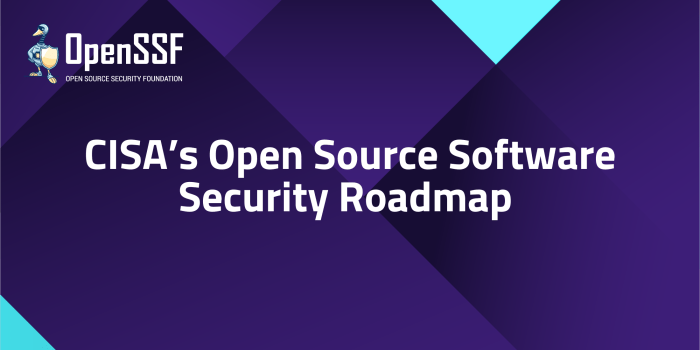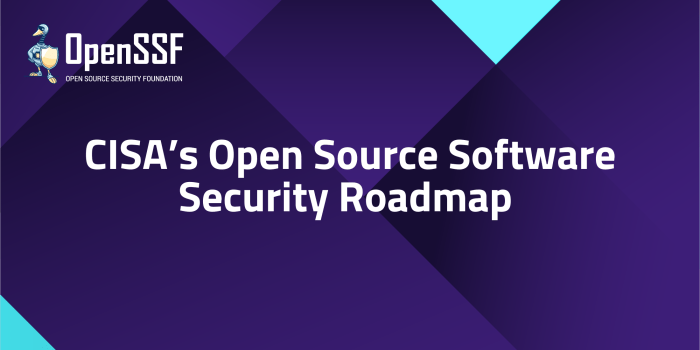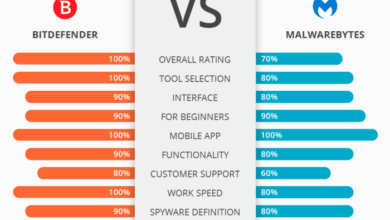
CISA Open Source Security Roadmap: A Guide to Safer Software
The CISA Open Source Security Roadmap sets the stage for a more secure digital landscape, offering organizations a comprehensive guide to navigating the complexities of open source software security. This roadmap, developed by the Cybersecurity and Infrastructure Security Agency (CISA), provides a clear path for organizations to identify, mitigate, and manage risks associated with open source components within their systems.
The roadmap emphasizes the importance of proactive security measures, highlighting the need for robust security practices throughout the software development lifecycle. It addresses key aspects such as identifying vulnerabilities, implementing secure coding practices, and establishing effective security controls. By adopting the roadmap’s recommendations, organizations can significantly strengthen their security posture and protect their critical assets from cyber threats.
Introduction to CISA Open Source Security Roadmap
The CISA Open Source Security Roadmap is a comprehensive document outlining the Cybersecurity and Infrastructure Security Agency’s (CISA) approach to enhancing the security of open-source software. This roadmap serves as a guide for organizations, developers, and users to understand and address security vulnerabilities in open-source software, ultimately fostering a more secure digital environment.
The Roadmap’s Purpose and Objectives
The CISA Open Source Security Roadmap aims to strengthen the security posture of open-source software by promoting collaboration, sharing best practices, and fostering a more secure development ecosystem. The roadmap’s objectives include:
- Improving awareness of open-source security risks and vulnerabilities: The roadmap aims to educate organizations and individuals about the potential security threats associated with open-source software. This includes highlighting common vulnerabilities, attack vectors, and mitigation strategies.
- Promoting secure development practices: The roadmap encourages developers to adopt secure coding practices, utilize security tools, and incorporate security considerations throughout the software development lifecycle. This helps to minimize vulnerabilities from the outset.
- Enhancing vulnerability detection and remediation: The roadmap emphasizes the importance of identifying and addressing vulnerabilities in open-source software promptly and effectively. This includes promoting the use of vulnerability scanning tools, coordinating vulnerability disclosure, and facilitating timely patching.
- Fostering collaboration and information sharing: The roadmap encourages collaboration between organizations, developers, and researchers to share knowledge, best practices, and vulnerability information. This collective effort helps to build a more secure and resilient open-source ecosystem.
The Importance of Open Source Security in Today’s Digital Landscape
Open-source software plays a critical role in today’s digital landscape, powering everything from websites and applications to operating systems and cloud infrastructure. The widespread adoption of open-source software makes it essential to prioritize its security.
- Ubiquitous use: Open-source software is used by virtually every organization and individual, making its security a matter of public interest. A single vulnerability in a widely used open-source component can potentially impact millions of users.
- Transparency and community involvement: The open-source model fosters transparency and community involvement, enabling developers and security researchers to collaborate and identify vulnerabilities. However, this also means that vulnerabilities can be discovered and exploited more quickly.
- Rapid evolution and innovation: Open-source software often evolves rapidly, with new features and updates being released frequently. This can create challenges for security teams, who need to keep pace with the latest changes and address emerging vulnerabilities.
- Dependency chains and supply chain risks: Open-source software often relies on numerous dependencies, creating complex supply chains that can be vulnerable to attacks. A compromise in a single dependency can potentially affect the entire software ecosystem.
Key Components of the Roadmap

The CISA Open Source Security Roadmap is a comprehensive framework designed to guide organizations in securing their use of open source software. The roadmap is divided into distinct phases, each addressing a critical aspect of open source security. Each phase provides specific recommendations and guidelines to enhance the overall security posture of organizations leveraging open source software.
Phase 1: Understanding Open Source Security
This phase focuses on building a foundational understanding of open source security principles and best practices. It emphasizes the importance of incorporating open source security considerations into an organization’s overall security strategy.
- Identify Open Source Software Usage: Organizations must first understand the scope of their open source software usage, including identifying all software components, their dependencies, and licenses. This process is essential for gaining a comprehensive overview of the open source software landscape within the organization.
The CISA Open Source Security Roadmap is a valuable resource for organizations looking to strengthen their security posture. It emphasizes the importance of securing data throughout its lifecycle, including “data in use,” a crucial aspect that often gets overlooked. For a deeper dive into “data in use” security best practices, check out this excellent article on data in use data security.
The CISA roadmap aligns perfectly with this concept, providing guidance on securing open source software, which is often used in data processing and analysis.
- Assess Open Source Security Risks: This involves evaluating the potential security risks associated with the use of open source software. This assessment should consider factors such as vulnerabilities, licensing compliance, and the maturity of the open source community supporting the software.
- Develop a Secure Open Source Software Policy: Organizations should establish clear policies and procedures for acquiring, using, and managing open source software. These policies should Artikel the organization’s approach to security, vulnerability management, and compliance.
Phase 2: Implementing Secure Open Source Practices
This phase focuses on implementing practical security measures to mitigate the risks associated with open source software.
- Secure Software Supply Chain: Organizations should implement robust processes to ensure the integrity and security of their open source software supply chain. This includes verifying the authenticity of software components, securing the development environment, and implementing secure software development practices.
- Vulnerability Management: Organizations should have a comprehensive vulnerability management program in place to identify, assess, and mitigate vulnerabilities in open source software. This includes regularly scanning for known vulnerabilities, implementing patch management practices, and maintaining a vulnerability database.
- Open Source Software License Compliance: Organizations must ensure compliance with the licenses associated with their open source software. This involves understanding the terms and conditions of each license and ensuring that the organization’s usage complies with these terms.
Phase 3: Continuous Monitoring and Improvement
This phase emphasizes the importance of ongoing monitoring and continuous improvement of open source security practices.
The CISA Open Source Security Roadmap is a vital resource for organizations seeking to improve their security posture. It’s a roadmap, not a recipe, but if I were to cook up a metaphor, it’s like the difference between a meticulously planned out recipe for lobster baked macaroni cheese and just throwing ingredients together and hoping for the best.
The roadmap provides guidance and structure, ensuring you don’t miss any crucial steps in building a robust and secure open-source ecosystem.
- Monitor Open Source Software Usage: Organizations should continuously monitor their open source software usage to track changes in software components, dependencies, and licenses. This allows for proactive identification of potential security risks.
- Assess and Improve Security Practices: Organizations should regularly review and assess their open source security practices to identify areas for improvement. This includes evaluating the effectiveness of their security measures, policies, and procedures.
- Engage with the Open Source Community: Active engagement with the open source community is crucial for staying informed about security best practices, vulnerabilities, and emerging threats. This includes participating in open source forums, reporting vulnerabilities, and contributing to open source projects.
Collaboration and Community Engagement
The success of the CISA Open Source Security Roadmap relies heavily on collaboration and community engagement.
“Open source security is a shared responsibility. It requires collaboration among organizations, developers, and the open source community.”
Sharing best practices, vulnerabilities, and threat intelligence is essential for collective security. Organizations can participate in industry forums, share knowledge through publications and presentations, and contribute to open source projects. This collaborative approach strengthens the overall security posture of the open source ecosystem.
Benefits of Adopting the Roadmap
Embracing the CISA Open Source Security Roadmap offers a multitude of benefits for organizations, empowering them to enhance their security posture and navigate the complexities of open-source software. This roadmap provides a structured approach to managing open-source security risks, leading to improved resilience, reduced vulnerabilities, and enhanced operational efficiency.
The CISA Open Source Security Roadmap is a vital resource for understanding and mitigating vulnerabilities in open-source software. It’s a complex topic, but sometimes a break from the technical world is needed. If you’re looking for a fun and creative outlet, check out elsies guide to painting with kiddos for some inspiration.
After a relaxing painting session, you’ll be ready to tackle the CISA roadmap with renewed focus and energy!
Increased Security Posture
Adopting the roadmap helps organizations proactively identify and mitigate vulnerabilities within their open-source software ecosystem. The roadmap provides a comprehensive framework for conducting regular security assessments, ensuring that all open-source components are thoroughly vetted and patched against known vulnerabilities.
- Regular Vulnerability Scanning:By integrating vulnerability scanning tools into their development workflows, organizations can identify and address vulnerabilities early in the development cycle, reducing the risk of exploitation.
- Software Bill of Materials (SBOM):The roadmap emphasizes the importance of maintaining a comprehensive SBOM, providing a detailed inventory of all open-source components used within an organization’s software. This facilitates efficient vulnerability analysis and patch management.
- Security Best Practices:The roadmap promotes the adoption of secure coding practices, secure software development lifecycle (SDLC) processes, and robust security controls, which collectively contribute to a more secure software environment.
Reduced Security Risks
The roadmap Artikels a systematic approach to managing open-source security risks, effectively reducing the likelihood of security breaches and data compromises.
- Proactive Vulnerability Management:By prioritizing the identification and remediation of vulnerabilities, organizations can significantly minimize their exposure to potential attacks. The roadmap encourages the use of automated tools and processes to streamline vulnerability management activities.
- Supply Chain Security:The roadmap emphasizes the importance of securing the entire software supply chain, including open-source components. This involves vetting third-party vendors, implementing secure software acquisition practices, and establishing robust governance processes for managing open-source dependencies.
- Incident Response:The roadmap provides guidance on developing comprehensive incident response plans specifically tailored to address open-source security incidents. This ensures that organizations are prepared to respond effectively and efficiently to security breaches involving open-source software.
Cost Savings and Improved Efficiency
By adopting the roadmap, organizations can achieve significant cost savings and improve operational efficiency through a more streamlined and effective approach to open-source security.
- Reduced Remediation Costs:By proactively identifying and mitigating vulnerabilities, organizations can avoid costly security breaches and the associated remediation efforts. This includes minimizing downtime, data recovery costs, and legal liabilities.
- Enhanced Developer Productivity:The roadmap’s focus on automated tools and processes helps developers seamlessly integrate security practices into their workflows, improving efficiency and reducing the time spent on manual security tasks.
- Improved Compliance:The roadmap aligns with industry best practices and regulatory requirements, simplifying compliance efforts and reducing the risk of non-compliance penalties.
Implementation Strategies
The CISA Open Source Security Roadmap provides a comprehensive framework for organizations to enhance their security posture by leveraging open source software. Implementing this roadmap involves a systematic approach that considers organizational context, resources, and priorities. This section Artikels the key steps involved in adopting and implementing the roadmap, emphasizing the importance of security assessments, risk analysis, and continuous monitoring and evaluation.
Security Assessments and Risk Analysis
A comprehensive security assessment is crucial to identify existing vulnerabilities and risks associated with open source software within an organization. This assessment should involve a thorough review of the organization’s current security practices, open source software inventory, and potential vulnerabilities.
The assessment should be conducted using a structured methodology, such as the NIST Cybersecurity Framework (CSF), to ensure a comprehensive and standardized approach.
Security assessments and risk analysis should be conducted regularly, at least annually, or more frequently if significant changes occur in the organization’s open source software usage or security landscape.
The following steps are essential for conducting effective security assessments and risk analysis:
- Inventory Open Source Software:Identify all open source software components used within the organization, including libraries, frameworks, and tools. This can be achieved through automated software composition analysis (SCA) tools or manual analysis of source code.
- Assess Vulnerabilities:Evaluate each identified open source component for known vulnerabilities. This can be done by leveraging vulnerability databases such as the National Vulnerability Database (NVD), Open Source Vulnerability Database (OSVDB), and the Common Vulnerabilities and Exposures (CVE) list.
- Prioritize Risks:Analyze the identified vulnerabilities based on their severity, likelihood of exploitation, and impact on the organization. This helps prioritize remediation efforts and focus on the most critical risks.
- Develop Remediation Plans:Create detailed plans to address identified vulnerabilities. This may involve updating to the latest version of the software, applying security patches, or implementing mitigating controls.
- Implement Security Controls:Implement appropriate security controls to reduce the risk of exploitation. This can include access controls, intrusion detection systems (IDS), firewalls, and security information and event management (SIEM) systems.
Best Practices for Open Source Security
Securing open source software is a critical aspect of any organization’s security posture. By adopting a robust set of best practices, organizations can significantly reduce their exposure to vulnerabilities and ensure the integrity of their applications.
Key Best Practices for Open Source Security
The following table highlights some of the key best practices for securing open source software:
| Best Practice | Description | Implementation Steps | Benefits |
|---|---|---|---|
| Use a Software Bill of Materials (SBOM) | An SBOM is a comprehensive list of all software components used in an application. It provides transparency into the software supply chain and helps identify potential vulnerabilities. |
|
|
| Regularly Update Open Source Components | Keeping open source components up-to-date is essential for patching vulnerabilities and ensuring the security of applications. |
|
|
| Perform Security Audits | Regular security audits help identify vulnerabilities that may have been missed during development or testing. |
|
|
| Implement Secure Coding Practices | Secure coding practices help prevent vulnerabilities from being introduced into the codebase in the first place. |
|
|
Role of Security Tools and Automation
Security tools and automation play a critical role in securing open source software. These tools can help automate tasks such as:
- Vulnerability Scanning:Tools like Snyk, Dependabot, and OWASP Dependency Check can automatically scan open source components for known vulnerabilities.
- SBOM Generation:Tools like CycloneDX and SPDX can generate SBOMs, providing a comprehensive list of software components.
- Security Testing:Tools like Burp Suite and ZAP can be used to perform penetration testing and identify security flaws in applications.
- Policy Enforcement:Tools like GitLab CI/CD and Jenkins can be used to enforce security policies and prevent the use of vulnerable components.
Examples of Successful Open Source Security Initiatives, Cisa open source security roadmap
Several organizations have implemented successful open source security initiatives. Here are a few examples:
- The Linux Foundation’s Core Infrastructure Initiative (CII):CII provides resources and best practices for securing open source software. It has developed a set of best practices for open source security, known as the “CII Best Practices Badge.”
- The Open Source Security Foundation (OpenSSF):OpenSSF is a non-profit organization that works to improve the security of open source software. It has developed several initiatives, including the “Alpha-Omega” project, which aims to improve the security of open source software supply chains.
- The National Institute of Standards and Technology (NIST):NIST has published several guidelines and standards for securing open source software, including the “NIST Cybersecurity Framework” and the “NIST Special Publication 800-161.”
Future Directions and Trends: Cisa Open Source Security Roadmap
The landscape of open source security is constantly evolving, driven by advancements in technology, changing threat vectors, and evolving regulatory landscapes. Understanding these trends is crucial for organizations to stay ahead of the curve and secure their open source software effectively.
Impact of AI and Machine Learning
AI and machine learning are transforming the open source security landscape, offering new opportunities to automate security tasks and enhance vulnerability detection.
- Automated Vulnerability Detection: AI-powered tools can analyze vast amounts of code, identifying vulnerabilities that might be missed by traditional methods. These tools can learn from existing vulnerabilities and patterns to predict potential weaknesses in new codebases. For instance, tools like Snyk and GitGuardian use AI to scan open source libraries for known vulnerabilities and potential security risks.
- Improved Security Posture: AI can be used to analyze security logs and identify suspicious activity, helping organizations detect and respond to threats more effectively. It can also be used to prioritize vulnerabilities based on their potential impact and recommend appropriate remediation steps.
- Automated Code Remediation: AI can be used to suggest code changes to fix vulnerabilities, potentially reducing the time and effort required for remediation. While still in its early stages, this technology holds significant promise for improving the efficiency of open source security.
Emerging Trends and Challenges
The open source security landscape faces new challenges as technology advances and threat actors become more sophisticated.
- Supply Chain Attacks: These attacks target the software supply chain, aiming to compromise open source components used by many organizations. The SolarWinds attack, where malicious code was inserted into a widely used software update, is a prime example. Organizations need to prioritize securing their software supply chains by carefully vetting open source components and using tools like Software Bill of Materials (SBOM) to track dependencies.
- Rise of Open Source Software Development: Open source software development is becoming increasingly popular, but this trend also brings new security challenges. The decentralized nature of open source development makes it difficult to track all contributors and ensure code quality. Organizations need to be vigilant about the security of open source components they use and consider contributing to open source projects to improve their security.
- The Growing Complexity of Open Source Software: Open source software is often highly complex, making it difficult to analyze and secure. This complexity can make it challenging to identify and mitigate vulnerabilities, particularly in large and intricate projects. Organizations need to invest in tools and expertise to effectively manage the security of complex open source software.
Areas for Further Research and Development
There are several areas where further research and development are needed to advance open source security.
- Development of Automated Security Testing Tools: More sophisticated AI-powered tools are needed to automate security testing, including vulnerability detection, code analysis, and security audits. These tools should be able to handle the complexity of modern open source software and provide actionable insights for security teams.
- Research on Secure Open Source Development Practices: More research is needed to understand and develop best practices for secure open source development. This includes areas like secure coding, vulnerability management, and supply chain security.
- Development of Open Source Security Standards: There is a need for standardized approaches to open source security, including guidelines for vulnerability disclosure, security audits, and best practices for secure development. These standards would provide a framework for organizations to ensure the security of their open source software.







